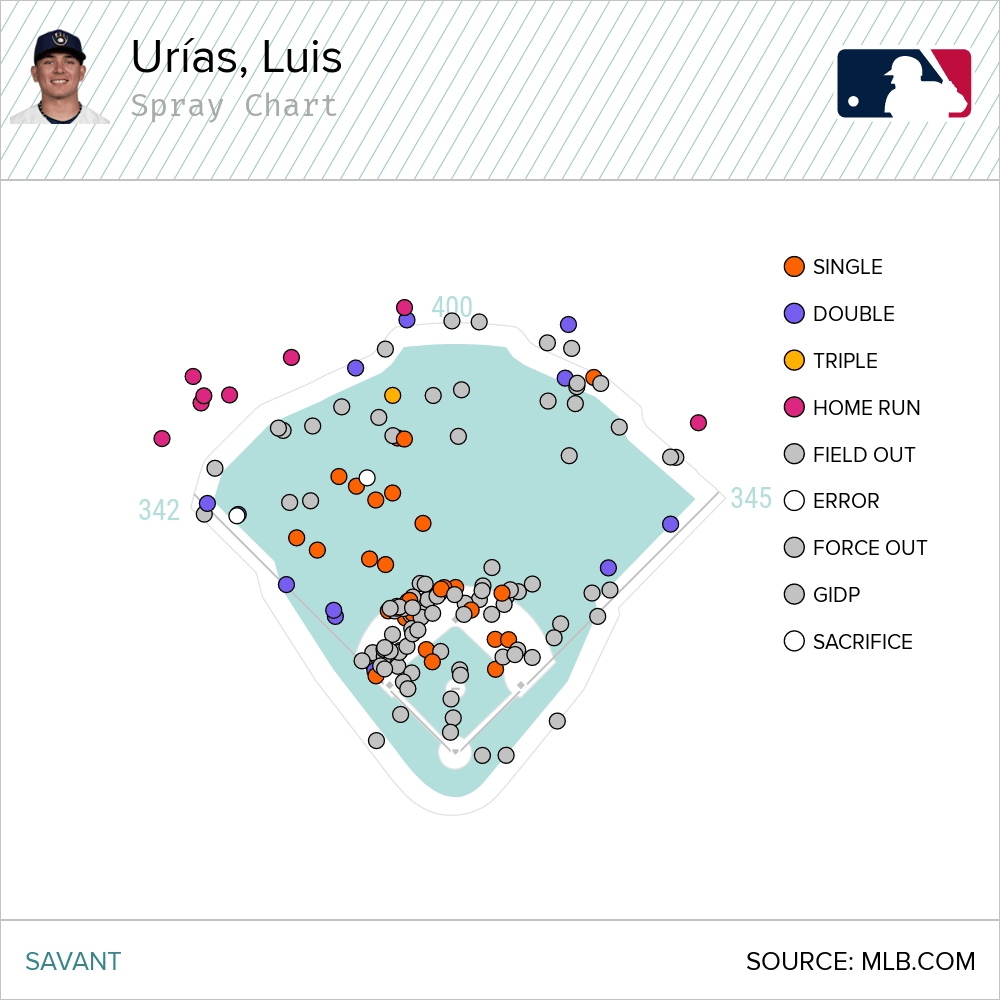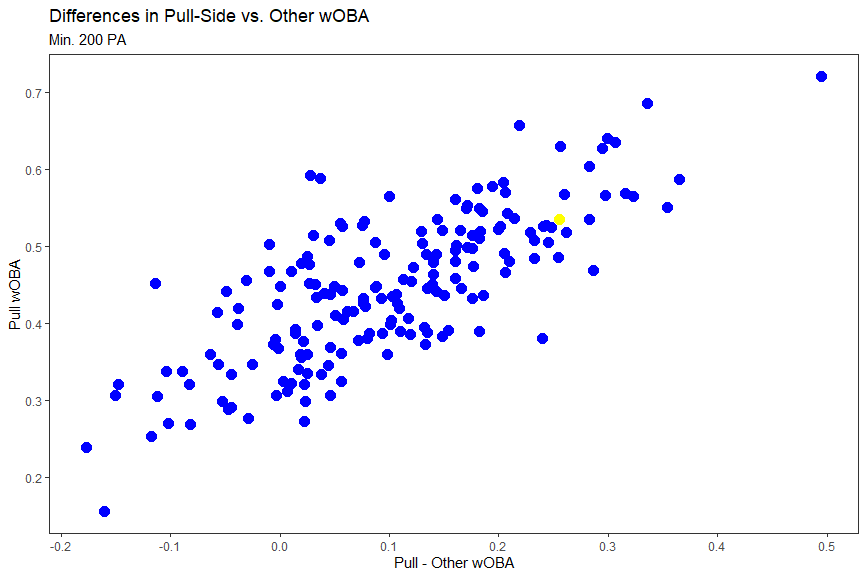Expectations were high when the Milwaukee Brewers acquired Luis Urías from the San Diego Padres in the winter of 2019. He was, after all, one of the top prospects in the whole game, ranking somewhere in the top-30, depending on the prospect outlet. The Brewers gave up the promising outfielder Trent Grisham in the deal, which certainly looks like it’s paid off the Padres, and maybe making this trade perhaps looks a little underwhelming for the Brewers’ side. Urías was expected to be the team’s answer in the middle infield, and for good reason. He had a career .308 batting average in the minor leagues. That profile as a high batting average, strong plate discipline, and all-fields ability hitter was expected to translate well to the Majors. It did not quite work out that way in the shortened 2020 season, as Urías was quite disappointing, as he posted a paltry 67 wRC+ in 47 games.
Still, Urías just turned 24-years-old earlier this month, and the prospect pedigree was too high to simply say that he was a bust just yet. He has been better this season with 109 wRC+. It’s a mark that probably doesn’t get many excited. However, it is importantly still better than average, and he adds versatility with the ability to play second base, third base, and shortstop. At the same time, though, Urías is productive at the plate in a much different way from what his scouting reports have suggested. Instead of having a high batting average over .300, Urías is sitting in the low .200’s— currently at .238. Indeed, looking at his overall .238/.341/.419 slash line, it becomes clear that a lot of that success right now is coming from the power and on-base side of things.
It’s interesting because that’s not the type of player Urías was billed at all. He had just a .125 isolated power mark in the minor leagues. He had hit just four Major League home runs in his first 369 plate appearances through the end of the 2020 season. However, this season, however, Urías’ .181 isolated power easily trumps his minor league numbers, and he has surpassed his home runs totals, as he has eight home runs in just 247 plate appearances. Urías is getting it done in a different way at the player this season, and the differences are clear, especially in the month of June:
Suddenly, Urías looks like a much different hitter. How exactly has this happened? Let’s take a closer look at his profile and see what’s been causing his sudden power surge.
The gist of it seems to be that Urías is simply hitting the ball much better this year. Just looking at the surface-level Statcast metrics, it becomes quite clear:
These are improvements in every area, but especially so when compared to last year. However, what really stands out here is that pretty much everything here grades out as being greater than the league average, especially maximum exit velocity. It’s the standout metric of his profile, which despite his small frame and profile that wouldn’t suggest a strong mark here, it does place inside the top-20% in this department, which is quite encouraging. There’s a lot to like about the rest of it, though, as these are all currently career-highs for him. As one might guess, Urías has been one of the best improvers in these metrics, not just from 2020 to 2021, but even going back to 2019 and looking cumulatively as well. First, let’s see the improvers in average launch angle:
We see that Urías ranks sixth-highest in average launch angle improvement. Next, how about the biggest max exit velocity improvers?
This time, Urías is second-best. Moving on, this time let’s see those with the biggest surge in hard-hit rate:
Once again, Urías ranks second-best among the improvers. And now finally, the largest improvers in barrel rate, where Urías again is the sixth-largest improver:
From this, we see that Urías has made great strides in these areas over the course of his Major League career. That on its own is definitely promising, but what also helps and leads to the improvements on the power side of things is that Urías is hitting more balls in the air as well—which makes sense considering he’s seen a spike in average launch angle this year. While he hasn’t suddenly joined the “launch angle revolution,” it’s been more about him getting his groundball rate down to a rate that’s better than league average. It’s also the lowest groundball rate of his career:
Again, the major difference is just how much of an improvement it’s been from last season to the current one. The rate of airballs is admittedly not all that different from 2019, but the difference has been that to go along with a better batted-ball distribution, he’s hitting the ball much harder, which has had an impact on his power-related metrics, as those improvements on the batted ball side show up in the better-batted ball types: line drives and fly balls:
Without a doubt, Urías has improved in this area, which has, in turn, helped his power numbers trend up. We saw that his isolated power has shot way up, but he’s also seen a surge in HR/FB rate, going from a 6.5% rate in 2019 and 2020 combined to a 13.6% rate this year—which is right alongside the league average.
But what has also been a big factor for Urías on the power-side of things has to do with where these batted balls are going. When looking at Urías, he doesn’t stand out as being a pull-heavy hitter. His pull-rate this year is a career-high, but at just 39.9%, it isn’t much higher than the league average of around 36.6%, nor is it much different than his 2020 rate of 36.4%. Overall, it seems as if Urías is rather even, being just a few percentage points in either direction from league average when it comes to his spraying of batted balls.
However, despite not having a super pull-heavy profile, Urías does seem to get better results when he pulls the ball. For instance, compare his overall spray chart to where his base hits have landed:

It looks like the common theme here is that the majority of his hits have gone to the pull-side—including most of his home runs. Breaking things out to look at how Urías fares when he goes to the pull-side compared to the other directions, we see that he just generally seems to hit the ball better when he pulls it:
In terms of wOBA to the pull-side, Urías ranks 27th-highest, and in slugging, he ranks 28th-highest. Urías definitely grades out well in terms of pulling the ball, but not so much to the other sides of the field. In fact, he has one of the largest discrepancies between both wOBA and slugging to the pull side compared to the other sides. See the below scatterplot, with Urías being the point in yellow:

It is true that most hitters are better when going to the pull-side, but it looks to be true even more so for Urías. It seems like pulling the ball is crucial to his success, as his .255 difference in wOBA to the pulled side compared to the other directions is the 17th-highest among hitters with the 200 plate appearance qualifier.
It does make sense since pulled balls usually produce better results than to the other directions—especially fly balls and line drives. It’s true in the case of Urías, too, as on his pulled fly balls and line drives he has a wOBA/SLG combo of .825/1.448 against a .451/.718 mark on balls to straightaway and the opposite field—a stark difference which is not unlike his overall results by direction. It’s not a mark against Urías, but rather, after seeing the difference in performance to the pull side, the case could likely be made for Urías to buy into this approach even more and try to pull the ball even more than he currently is.
A potential downside of a more pull-heavy, power-emphasized approach would be that he likely wouldn’t be hitting for the high .300+ batting average that was expected from him at one point. His .290 BABIP is perhaps a little low. Still, it generally is difficult for hitters with similar approaches to hit for a high batting average, especially in Urías’ situation in that he isn’t getting much help at all from the batted balls going to the other parts of the field. Combine that with a strikeout rate over 20%, and it just doesn’t seem all that likely, in his current form, for him to be much of a positive on the batting-average side of things.
If there is one thing that will help him out, though, it is that he is walking at a solid 12.5% rate—which helps prop up him and makes him look a little less one-dimensional as a hitter. He’s been swinging a lot more at pitches inside the zone (66% this year, 56% last year) while continuing to do a good job of laying off enough pitches out of the zone (26.7% chase rate vs. 28.4% league average), which has led to more walks.
Overall, this version of Urías that we’re seeing at the plate right now looks pretty different from the one that he was pegged to be as one of the game’s top prospects, but it does seem like this has been a better one. After failing to make much of an impact through parts of three Major League seasons, Urías looks to have made some adjustments now in the fourth season he’s been a part of. He’s hitting the ball much better, as he has been one of the largest improvers this season in a handful of Statcast metrics while also hitting more balls in the air. That combination of more hard-hit balls in the air is a good recipe for an increase in power, and it seems to be working for Urías right now. To go along with that, despite not having a super pull-centric profile, he has been getting great results when he pulls the ball, which could possibly open the door for a more pull-centric approach going forward.
Is this type of performance sustainable? We’ll have to find out, but for now, it looks like after a slow start to his tenure as a Brewer, Urías is starting to figure things out, and he’s having the type of impact that was expected when the team traded for him as one of the better hitters in their lineup.
Photo by Keith Gillett/Icon Sportswire | Adapted by Aaron Polcare


Loved seeing this piece after my move to drop Gleyber Torres — broke my heart as a Yankee fan but had to be done — for Urias.
Now the Brewers need to stop slotting him in the 7-hole, but I digress.
Thanks for reading, Jack. Yes, as a fellow Yankee fan, it sure has been frustrating to watch Torres this year.
Definitely liked Urias a lot more when he was hitting leadoff for the Brewers while Wong was injured. Still like him obviously, but it would be much better if he was still at the top of the order.
Great analysis Matt – much appreciated. I’ve always been a fan of Urias and feel like he would have been further along in his development if he hadn’t been shuffling between the majors and minors in 2018 and 2019. I also think 2020 should be considered a mulligan… for a lot of players. Long-term, I can easily see Urias consistently hitting 270+ with 12+ % BB rate and 175+ ISO.
Thanks Dave, glad you liked it. Absolutely, 2020 should pretty much be written off completely. He also was dealing with a wrist injury last year, which I’m sure had an impact on him. I think that .270, 12% BB rate and .175 is a realistic expectation for him going forward, which would definitely be a fine profile. I wouldn’t complain about that at all.